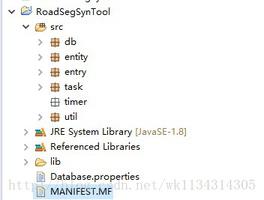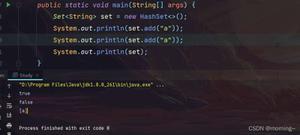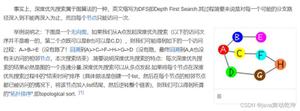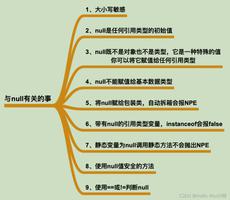java.util.Stack

import java.util.Stack;public class Test {
public static void main(String[] args) {
Stack stack = new Stack<>();
stack.push("a");
stack.push("b");
stack.push("c");
System.out.println("********************* pop **************");
Object popVal = stack.pop();
System.out.println(popVal);
System.out.println(stack.size());
System.out.println("********************* peek **************");
Object peekVal = stack.peek();
System.out.println(peekVal);
System.out.println(stack.size());
System.out.println("********************* empty **************");
System.out.println(stack.isEmpty());
System.out.println(stack.empty());
System.out.println(stack.isEmpty());
System.out.println(stack.size());
System.out.println("********************* clear **************");
stack.clear();
System.out.println(stack.empty());
System.out.println(stack.isEmpty());
System.out.println(stack.size());
}
}
结果:
********************* pop **************c
2
********************* peek **************
b
2
********************* empty **************
false
false
false
2
********************* clear **************
true
true
0
实现原理:
Stack继承自Vector,通过Vector里面的方法定义自己的push、pop、peek、empty、search方法实现栈的功能。
Stack的源码如下:
/** Copyright (c) 1994, 2010, Oracle and/or its affiliates. All rights reserved.
* ORACLE PROPRIETARY/CONFIDENTIAL. Use is subject to license terms.
*
*
*
*
*
*
*
*
*
*
*
*
*
*
*
*
*
*
*
*
*/
package java.util;
/**
* The <code>Stack</code> class represents a last-in-first-out
* (LIFO) stack of objects. It extends class <tt>Vector</tt> with five
* operations that allow a vector to be treated as a stack. The usual
* <tt>push</tt> and <tt>pop</tt> operations are provided, as well as a
* method to <tt>peek</tt> at the top item on the stack, a method to test
* for whether the stack is <tt>empty</tt>, and a method to <tt>search</tt>
* the stack for an item and discover how far it is from the top.
* <p>
* When a stack is first created, it contains no items.
*
* <p>A more complete and consistent set of LIFO stack operations is
* provided by the {@link Deque} interface and its implementations, which
* should be used in preference to this class. For example:
* <pre> {@code
* Deque<Integer> stack = new ArrayDeque<Integer>();}</pre>
*
* @author Jonathan Payne
* @since JDK1.0
*/
public
class Stack<E> extends Vector<E> {
/**
* Creates an empty Stack.
*/
public Stack() {
}
/**
* Pushes an item onto the top of this stack. This has exactly
* the same effect as:
* <blockquote><pre>
* addElement(item)</pre></blockquote>
*
* @param item the item to be pushed onto this stack.
* @return the <code>item</code> argument.
* @see java.util.Vector#addElement
*/
public E push(E item) {
addElement(item);
return item;
}
/**
* Removes the object at the top of this stack and returns that
* object as the value of this function.
*
* @return The object at the top of this stack (the last item
* of the <tt>Vector</tt> object).
* @throws EmptyStackException if this stack is empty.
*/
public synchronized E pop() {
E obj;
int len = size();
obj = peek();
removeElementAt(len - 1);
return obj;
}
/**
* Looks at the object at the top of this stack without removing it
* from the stack.
*
* @return the object at the top of this stack (the last item
* of the <tt>Vector</tt> object).
* @throws EmptyStackException if this stack is empty.
*/
public synchronized E peek() {
int len = size();
if (len == 0)
throw new EmptyStackException();
return elementAt(len - 1);
}
/**
* Tests if this stack is empty.
*
* @return <code>true</code> if and only if this stack contains
* no items; <code>false</code> otherwise.
*/
public boolean empty() {
return size() == 0;
}
/**
* Returns the 1-based position where an object is on this stack.
* If the object <tt>o</tt> occurs as an item in this stack, this
* method returns the distance from the top of the stack of the
* occurrence nearest the top of the stack; the topmost item on the
* stack is considered to be at distance <tt>1</tt>. The <tt>equals</tt>
* method is used to compare <tt>o</tt> to the
* items in this stack.
*
* @param o the desired object.
* @return the 1-based position from the top of the stack where
* the object is located; the return value <code>-1</code>
* indicates that the object is not on the stack.
*/
public synchronized int search(Object o) {
int i = lastIndexOf(o);
if (i >= 0) {
return size() - i;
}
return -1;
}
/** use serialVersionUID from JDK 1.0.2 for interoperability */
private static final long serialVersionUID = 1224463164541339165L;
}
以上是 java.util.Stack 的全部内容, 来源链接: utcz.com/z/390821.html









